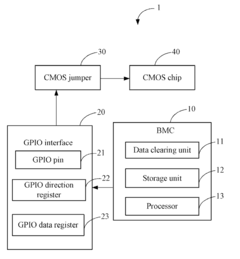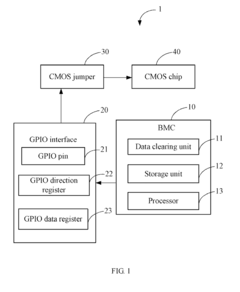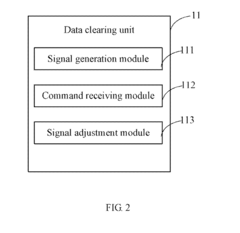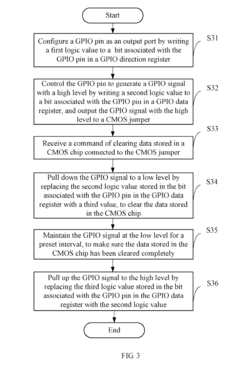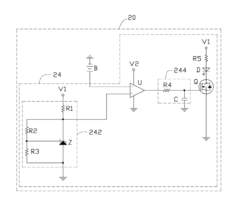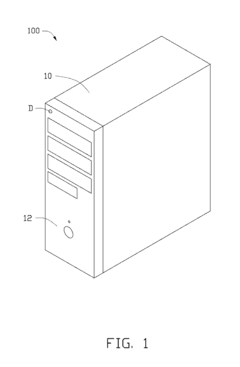How CMOS Battery Anchors Evolutionary Software Production Environments?
JUL 22, 20258 MIN READ
Generate Your Research Report Instantly with AI Agent
Patsnap Eureka helps you evaluate technical feasibility & market potential.
CMOS Battery Evolution
The evolution of CMOS battery technology has played a crucial role in anchoring and supporting the development of software production environments. Initially introduced in the 1980s, CMOS batteries have undergone significant improvements to meet the increasing demands of modern computing systems.
In the early stages, CMOS batteries were primarily used to maintain basic system settings and real-time clock functions. As software development environments became more complex, the role of CMOS batteries expanded to include preserving critical configuration data and ensuring system stability during power interruptions.
The 1990s saw a shift towards lithium-based CMOS batteries, offering improved energy density and longer lifespan. This advancement allowed for more reliable long-term storage of system settings and configuration data, which became increasingly important as software development tools and environments grew in complexity.
The turn of the millennium brought about a new era of power management in computing systems. CMOS batteries evolved to work in tandem with advanced power management features, supporting the preservation of development environment states and enabling quick resume capabilities. This evolution significantly enhanced productivity in software development by reducing system startup times and maintaining work progress.
As cloud-based development environments gained popularity in the 2010s, CMOS batteries adapted to support hybrid local-cloud configurations. They began to play a crucial role in maintaining local system integrity and synchronization parameters, ensuring seamless integration between local development setups and cloud-based resources.
Recent advancements in CMOS battery technology have focused on improving energy efficiency and reducing environmental impact. The introduction of rechargeable CMOS batteries and integration with system power supplies has led to more sustainable and reliable software production environments.
Looking towards the future, CMOS battery technology is expected to continue evolving to meet the demands of increasingly distributed and virtualized development environments. Innovations in energy harvesting and storage technologies may lead to self-sustaining CMOS systems, further enhancing the reliability and flexibility of software production environments.
In the early stages, CMOS batteries were primarily used to maintain basic system settings and real-time clock functions. As software development environments became more complex, the role of CMOS batteries expanded to include preserving critical configuration data and ensuring system stability during power interruptions.
The 1990s saw a shift towards lithium-based CMOS batteries, offering improved energy density and longer lifespan. This advancement allowed for more reliable long-term storage of system settings and configuration data, which became increasingly important as software development tools and environments grew in complexity.
The turn of the millennium brought about a new era of power management in computing systems. CMOS batteries evolved to work in tandem with advanced power management features, supporting the preservation of development environment states and enabling quick resume capabilities. This evolution significantly enhanced productivity in software development by reducing system startup times and maintaining work progress.
As cloud-based development environments gained popularity in the 2010s, CMOS batteries adapted to support hybrid local-cloud configurations. They began to play a crucial role in maintaining local system integrity and synchronization parameters, ensuring seamless integration between local development setups and cloud-based resources.
Recent advancements in CMOS battery technology have focused on improving energy efficiency and reducing environmental impact. The introduction of rechargeable CMOS batteries and integration with system power supplies has led to more sustainable and reliable software production environments.
Looking towards the future, CMOS battery technology is expected to continue evolving to meet the demands of increasingly distributed and virtualized development environments. Innovations in energy harvesting and storage technologies may lead to self-sustaining CMOS systems, further enhancing the reliability and flexibility of software production environments.
Software Dev Needs
The software development industry is experiencing a growing demand for more efficient, flexible, and collaborative production environments. As software projects become increasingly complex and teams more distributed, there is a pressing need for tools and systems that can support evolutionary development practices. CMOS battery technology, traditionally associated with maintaining system time and BIOS settings in computers, is now playing a crucial role in anchoring these evolving software production environments.
The primary need in software development is for stable, persistent environments that can maintain state and configuration across power cycles and system reboots. This is where CMOS batteries come into play, providing a reliable power source for maintaining critical system information. In the context of software production environments, this translates to preserving development setups, tool configurations, and project states, even when systems are powered down or reconfigured.
Another significant need is for seamless integration of various development tools and platforms. Modern software development often involves a complex ecosystem of integrated development environments (IDEs), version control systems, continuous integration/continuous deployment (CI/CD) pipelines, and cloud-based services. CMOS battery-powered systems can help maintain the intricate configurations and connections between these tools, ensuring that developers can quickly resume work without spending time reconfiguring their environments.
Version control and change management are also critical aspects of software development. CMOS batteries can support systems that track and manage different versions of software, configurations, and development environments. This capability is essential for maintaining consistency across team members and ensuring that all developers are working with the same baseline configurations.
Furthermore, there is a growing need for rapid prototyping and experimentation in software development. CMOS battery-anchored systems can facilitate quick setup and teardown of development environments, allowing developers to easily switch between different project configurations or test new tools without losing their primary working environment.
Security and access control are paramount in software development, especially in collaborative and distributed teams. CMOS battery-powered systems can help maintain secure configurations and access credentials, ensuring that development environments remain protected even when systems are powered off or moved between locations.
Lastly, there is an increasing demand for energy-efficient and environmentally friendly development practices. CMOS batteries, known for their low power consumption and long life, align well with this need, providing a sustainable solution for maintaining persistent development environments without significant energy overhead.
The primary need in software development is for stable, persistent environments that can maintain state and configuration across power cycles and system reboots. This is where CMOS batteries come into play, providing a reliable power source for maintaining critical system information. In the context of software production environments, this translates to preserving development setups, tool configurations, and project states, even when systems are powered down or reconfigured.
Another significant need is for seamless integration of various development tools and platforms. Modern software development often involves a complex ecosystem of integrated development environments (IDEs), version control systems, continuous integration/continuous deployment (CI/CD) pipelines, and cloud-based services. CMOS battery-powered systems can help maintain the intricate configurations and connections between these tools, ensuring that developers can quickly resume work without spending time reconfiguring their environments.
Version control and change management are also critical aspects of software development. CMOS batteries can support systems that track and manage different versions of software, configurations, and development environments. This capability is essential for maintaining consistency across team members and ensuring that all developers are working with the same baseline configurations.
Furthermore, there is a growing need for rapid prototyping and experimentation in software development. CMOS battery-anchored systems can facilitate quick setup and teardown of development environments, allowing developers to easily switch between different project configurations or test new tools without losing their primary working environment.
Security and access control are paramount in software development, especially in collaborative and distributed teams. CMOS battery-powered systems can help maintain secure configurations and access credentials, ensuring that development environments remain protected even when systems are powered off or moved between locations.
Lastly, there is an increasing demand for energy-efficient and environmentally friendly development practices. CMOS batteries, known for their low power consumption and long life, align well with this need, providing a sustainable solution for maintaining persistent development environments without significant energy overhead.
CMOS Tech Challenges
CMOS technology, while fundamental to modern computing, faces several significant challenges in the context of evolutionary software production environments. One of the primary issues is the limited lifespan of CMOS batteries, which typically range from 3 to 10 years. This finite duration poses a risk to long-term data retention and system stability, particularly in environments where continuous operation and data integrity are critical.
The power consumption of CMOS chips remains a persistent challenge. As software production environments become more complex and demanding, the energy requirements of CMOS-based systems increase. This not only impacts the battery life but also raises concerns about heat generation and overall system efficiency. The need for more power-efficient CMOS designs is paramount to support the evolving needs of software development platforms.
Scalability presents another hurdle for CMOS technology in software production environments. As these environments grow in complexity and scale, the limitations of current CMOS architectures become more apparent. The need for higher processing speeds and increased memory capacity often outpaces the capabilities of existing CMOS solutions, necessitating frequent hardware upgrades or compromises in system performance.
The susceptibility of CMOS technology to electromagnetic interference (EMI) and electrostatic discharge (ESD) is a significant concern in software production settings. These environments often involve multiple electronic devices and frequent human interaction, increasing the risk of data corruption or system failures due to EMI or ESD events. Implementing robust protection mechanisms without compromising system performance remains a challenge.
As software production environments evolve, the demand for more advanced features such as real-time collaboration, cloud integration, and AI-assisted development tools increases. CMOS technology must adapt to support these emerging requirements, which often necessitate faster data processing, enhanced connectivity, and improved power management. The integration of CMOS with other technologies to create hybrid solutions capable of meeting these demands is an ongoing challenge.
Lastly, the environmental impact of CMOS battery disposal is becoming increasingly important. As organizations strive for sustainability, the need for more eco-friendly CMOS solutions that reduce electronic waste and minimize the use of harmful materials is growing. Developing CMOS technologies that are both high-performing and environmentally responsible represents a significant challenge for the industry.
The power consumption of CMOS chips remains a persistent challenge. As software production environments become more complex and demanding, the energy requirements of CMOS-based systems increase. This not only impacts the battery life but also raises concerns about heat generation and overall system efficiency. The need for more power-efficient CMOS designs is paramount to support the evolving needs of software development platforms.
Scalability presents another hurdle for CMOS technology in software production environments. As these environments grow in complexity and scale, the limitations of current CMOS architectures become more apparent. The need for higher processing speeds and increased memory capacity often outpaces the capabilities of existing CMOS solutions, necessitating frequent hardware upgrades or compromises in system performance.
The susceptibility of CMOS technology to electromagnetic interference (EMI) and electrostatic discharge (ESD) is a significant concern in software production settings. These environments often involve multiple electronic devices and frequent human interaction, increasing the risk of data corruption or system failures due to EMI or ESD events. Implementing robust protection mechanisms without compromising system performance remains a challenge.
As software production environments evolve, the demand for more advanced features such as real-time collaboration, cloud integration, and AI-assisted development tools increases. CMOS technology must adapt to support these emerging requirements, which often necessitate faster data processing, enhanced connectivity, and improved power management. The integration of CMOS with other technologies to create hybrid solutions capable of meeting these demands is an ongoing challenge.
Lastly, the environmental impact of CMOS battery disposal is becoming increasingly important. As organizations strive for sustainability, the need for more eco-friendly CMOS solutions that reduce electronic waste and minimize the use of harmful materials is growing. Developing CMOS technologies that are both high-performing and environmentally responsible represents a significant challenge for the industry.
Current CMOS Solutions
01 CMOS battery power management
Systems and methods for managing power in CMOS batteries, including techniques for monitoring battery voltage, implementing power-saving modes, and extending battery life through efficient power distribution and consumption in electronic devices.- CMOS battery power management: Systems and methods for managing power in CMOS batteries, including techniques for monitoring battery voltage, implementing power-saving modes, and extending battery life through efficient power distribution and consumption in electronic devices.
- CMOS battery replacement and backup systems: Innovations in CMOS battery replacement procedures and backup power systems to ensure continuous operation of critical components during battery changes or failures, including hot-swappable designs and temporary power storage solutions.
- CMOS battery integration in semiconductor devices: Advancements in integrating CMOS batteries directly into semiconductor devices and integrated circuits, focusing on miniaturization, improved efficiency, and enhanced performance of electronic systems.
- CMOS battery charging and monitoring circuits: Development of specialized circuits for charging CMOS batteries and monitoring their status, including voltage regulation, charge level indication, and automated charging systems to optimize battery performance and lifespan.
- CMOS battery applications in imaging devices: Utilization of CMOS batteries in imaging devices such as digital cameras and image sensors, focusing on power management for image processing, storage of camera settings, and maintaining time and date information.
02 CMOS battery replacement and backup systems
Innovations in CMOS battery replacement procedures and backup power systems to maintain critical data and settings during battery changes or failures, ensuring continuous operation of electronic devices and preserving system configurations.Expand Specific Solutions03 CMOS battery integration in semiconductor devices
Advancements in integrating CMOS batteries within semiconductor devices, including novel packaging techniques, on-chip battery solutions, and improved connectivity between the battery and other components to enhance overall system performance and reliability.Expand Specific Solutions04 CMOS battery charging and monitoring circuits
Development of specialized circuits for charging CMOS batteries and monitoring their status, incorporating features such as intelligent charging algorithms, voltage regulation, and battery health indicators to optimize battery performance and longevity.Expand Specific Solutions05 CMOS battery applications in imaging devices
Utilization of CMOS batteries in imaging devices such as cameras and image sensors, focusing on power management strategies, low-power modes, and efficient energy usage to extend operational time and improve device functionality.Expand Specific Solutions
Key CMOS Manufacturers
The CMOS battery technology market is in a mature stage, with a stable but relatively small market size due to its niche application in maintaining computer system settings. The competitive landscape is characterized by established players like Duracell and Energizer, alongside electronics manufacturers such as IBM, Dell, and HP, who integrate CMOS batteries into their products. The technology's maturity is evident in its widespread adoption across computing devices, with minimal recent innovations. Companies like Taiwan Semiconductor Manufacturing Co. and NXP Semiconductors play crucial roles in semiconductor production, indirectly supporting CMOS battery integration. While the technology remains essential for system stability, the focus has shifted towards improving energy efficiency and extending battery life in modern computing environments.
International Business Machines Corp.
Technical Solution: IBM has developed advanced CMOS battery management systems for their servers and mainframes. Their approach integrates hardware and software solutions to ensure system stability and data integrity. IBM's CMOS battery technology uses smart charging algorithms and predictive maintenance[1]. They have implemented a distributed power management system that monitors battery health across multiple nodes, allowing for seamless failover and reduced downtime[3]. IBM's solution also includes automated BIOS updates and configuration management tied to the CMOS battery status, ensuring consistent software environments across reboots and power cycles[5].
Strengths: Robust enterprise-grade solution, seamless integration with IBM hardware. Weaknesses: Potentially high cost, may be overly complex for smaller systems.
Avid Technology, Inc.
Technical Solution: Avid has developed specialized CMOS battery management solutions for their professional audio and video production systems. Their approach focuses on ensuring uninterrupted creative workflows and protecting project data. Avid's solution includes a redundant CMOS battery system with hot-swappable capabilities, allowing for battery replacement without system shutdown[8]. They have implemented a distributed configuration management system that replicates critical CMOS data across multiple storage locations, ensuring data integrity even in case of battery failure[10]. Avid's software also includes intelligent power management features that optimize system performance based on CMOS battery health and project requirements[12].
Strengths: Tailored for professional media production environments, focus on uninterrupted workflows. Weaknesses: Highly specialized, may not be applicable to general-purpose computing environments.
CMOS Battery Patents
Computing device and method for clearing data stored in complementary metal-oxide semiconductor chip
PatentInactiveUS20120047307A1
Innovation
- A computing device with a data clearing unit that uses a GPIO interface to configure a CMOS jumper, generating a high-level signal to maintain data and then pulling it down to clear data stored in the CMOS chip, allowing for safe and controlled data reset.
Host computer
PatentInactiveUS20120043993A1
Innovation
- Incorporating a voltage detection circuit within the host computer that includes a comparator, electronic switch, alarm unit, reference voltage generating circuit, and delay circuit to detect and alert the user when the battery voltage falls below a certain threshold, using a light emitting diode as an alarm unit.
Energy Efficiency
Energy efficiency is a critical consideration in the evolution of software production environments, particularly in relation to CMOS battery usage. The CMOS battery plays a crucial role in maintaining system settings and timekeeping functions, even when the main power source is disconnected. As software development environments become more complex and resource-intensive, the energy demands placed on these systems increase, making efficient power management essential.
In modern software production environments, the CMOS battery serves as a stable anchor for maintaining system integrity and continuity. Its low-power consumption characteristics allow it to operate for extended periods, typically several years, without replacement. This longevity is vital for ensuring the stability of development environments, where consistent system configurations and accurate timekeeping are essential for version control, build processes, and collaborative workflows.
However, the increasing complexity of software development tools and environments has led to greater power demands on computing systems. Integrated development environments (IDEs), version control systems, and continuous integration/continuous deployment (CI/CD) pipelines require significant computational resources, which can strain power management systems. This heightened energy consumption necessitates a focus on optimizing the energy efficiency of both hardware and software components in production environments.
To address these challenges, several strategies have emerged. Power-aware computing techniques are being integrated into development environments, allowing for dynamic scaling of system resources based on workload demands. This approach helps minimize unnecessary power consumption during periods of low activity while ensuring adequate performance during intensive tasks such as compilation or testing.
Additionally, advancements in CMOS battery technology have led to improved energy density and longer lifespans. Modern CMOS batteries utilize lithium-ion technology, offering higher capacity and more stable voltage output compared to traditional coin cell batteries. This evolution allows for more reliable operation of critical system functions over extended periods, reducing the frequency of battery replacements and associated system downtime.
Furthermore, software optimization techniques are being employed to reduce the overall energy footprint of development environments. This includes implementing more efficient algorithms, minimizing background processes, and utilizing cloud-based resources for computationally intensive tasks. By offloading certain operations to cloud infrastructure, local energy consumption can be reduced, leading to a more sustainable and cost-effective development ecosystem.
In modern software production environments, the CMOS battery serves as a stable anchor for maintaining system integrity and continuity. Its low-power consumption characteristics allow it to operate for extended periods, typically several years, without replacement. This longevity is vital for ensuring the stability of development environments, where consistent system configurations and accurate timekeeping are essential for version control, build processes, and collaborative workflows.
However, the increasing complexity of software development tools and environments has led to greater power demands on computing systems. Integrated development environments (IDEs), version control systems, and continuous integration/continuous deployment (CI/CD) pipelines require significant computational resources, which can strain power management systems. This heightened energy consumption necessitates a focus on optimizing the energy efficiency of both hardware and software components in production environments.
To address these challenges, several strategies have emerged. Power-aware computing techniques are being integrated into development environments, allowing for dynamic scaling of system resources based on workload demands. This approach helps minimize unnecessary power consumption during periods of low activity while ensuring adequate performance during intensive tasks such as compilation or testing.
Additionally, advancements in CMOS battery technology have led to improved energy density and longer lifespans. Modern CMOS batteries utilize lithium-ion technology, offering higher capacity and more stable voltage output compared to traditional coin cell batteries. This evolution allows for more reliable operation of critical system functions over extended periods, reducing the frequency of battery replacements and associated system downtime.
Furthermore, software optimization techniques are being employed to reduce the overall energy footprint of development environments. This includes implementing more efficient algorithms, minimizing background processes, and utilizing cloud-based resources for computationally intensive tasks. By offloading certain operations to cloud infrastructure, local energy consumption can be reduced, leading to a more sustainable and cost-effective development ecosystem.
CMOS Security Aspects
The security aspects of CMOS (Complementary Metal-Oxide-Semiconductor) technology play a crucial role in anchoring evolutionary software production environments. As software development processes become increasingly complex and distributed, the integrity and reliability of hardware components, particularly the CMOS battery, become paramount in maintaining system security.
CMOS batteries serve as a critical component in maintaining system configuration and real-time clock settings. Their role in preserving BIOS settings and system time directly impacts the security of software development environments. A compromised CMOS battery can lead to system instability, incorrect timestamps, and potential vulnerabilities in version control systems and build processes.
One of the primary security concerns related to CMOS batteries is the potential for unauthorized access to system settings. If an attacker gains physical access to a device, they may attempt to manipulate BIOS settings by removing or replacing the CMOS battery. This could potentially bypass security measures and allow for the installation of malicious firmware or the alteration of boot sequences.
To mitigate these risks, modern systems often implement additional security measures. These may include cryptographic signing of BIOS updates, secure boot processes, and hardware-based security modules that work in conjunction with the CMOS battery to ensure system integrity. Some advanced systems also employ tamper-evident mechanisms to detect any physical interference with the CMOS battery or related components.
In the context of evolutionary software production environments, the security provided by CMOS batteries extends beyond individual workstations. Continuous integration and deployment (CI/CD) pipelines rely heavily on accurate system timekeeping and consistent hardware configurations. A compromised CMOS battery in a build server could potentially lead to inconsistencies in compiled code, incorrect timestamps on commits, or failures in automated testing processes.
Furthermore, the longevity and reliability of CMOS batteries are essential for maintaining long-term security in software production environments. As these batteries have a finite lifespan, regular monitoring and replacement schedules are necessary to prevent unexpected system behavior or security vulnerabilities due to battery failure.
As software development practices evolve, the integration of cloud-based and distributed development environments introduces new challenges and considerations for CMOS security. Remote access to development resources and the increasing use of virtualization technologies require careful attention to how CMOS-related security measures are implemented and managed across diverse hardware platforms and cloud infrastructures.
CMOS batteries serve as a critical component in maintaining system configuration and real-time clock settings. Their role in preserving BIOS settings and system time directly impacts the security of software development environments. A compromised CMOS battery can lead to system instability, incorrect timestamps, and potential vulnerabilities in version control systems and build processes.
One of the primary security concerns related to CMOS batteries is the potential for unauthorized access to system settings. If an attacker gains physical access to a device, they may attempt to manipulate BIOS settings by removing or replacing the CMOS battery. This could potentially bypass security measures and allow for the installation of malicious firmware or the alteration of boot sequences.
To mitigate these risks, modern systems often implement additional security measures. These may include cryptographic signing of BIOS updates, secure boot processes, and hardware-based security modules that work in conjunction with the CMOS battery to ensure system integrity. Some advanced systems also employ tamper-evident mechanisms to detect any physical interference with the CMOS battery or related components.
In the context of evolutionary software production environments, the security provided by CMOS batteries extends beyond individual workstations. Continuous integration and deployment (CI/CD) pipelines rely heavily on accurate system timekeeping and consistent hardware configurations. A compromised CMOS battery in a build server could potentially lead to inconsistencies in compiled code, incorrect timestamps on commits, or failures in automated testing processes.
Furthermore, the longevity and reliability of CMOS batteries are essential for maintaining long-term security in software production environments. As these batteries have a finite lifespan, regular monitoring and replacement schedules are necessary to prevent unexpected system behavior or security vulnerabilities due to battery failure.
As software development practices evolve, the integration of cloud-based and distributed development environments introduces new challenges and considerations for CMOS security. Remote access to development resources and the increasing use of virtualization technologies require careful attention to how CMOS-related security measures are implemented and managed across diverse hardware platforms and cloud infrastructures.
Unlock deeper insights with Patsnap Eureka Quick Research — get a full tech report to explore trends and direct your research. Try now!
Generate Your Research Report Instantly with AI Agent
Supercharge your innovation with Patsnap Eureka AI Agent Platform!
